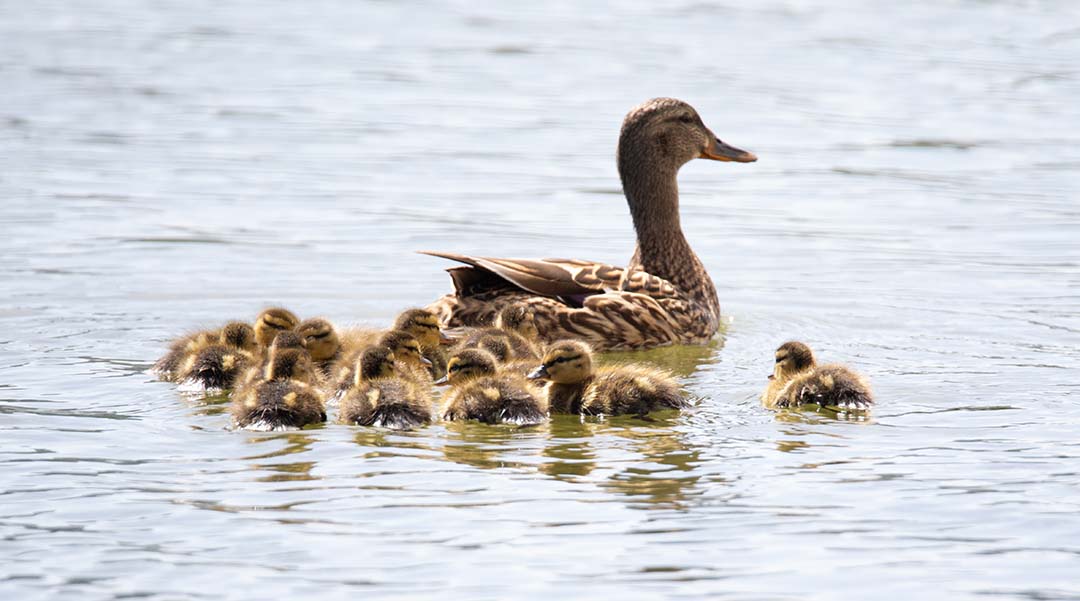Image credit: Anchor Lee on Unsplash
Mathematics and physics can be found in abundance throughout nature. From the ability of bees to build identical and repeating hexagonal honeycombs, to the seemingly endless intricacies of a fractal coastline, the laws that govern science logically govern nature. A new study has researched a similar application of physics in an unlikely place: ducks.
The new paper, published in the Journal of Fluid Mechanics, identifies two key mechanisms that allow a formation of ducklings to effortlessly and efficiently float through the water while following their mother.
As a duckling floats on water, like other floating objects, it experiences the force of hydrostatic pressure — as gravity pushes the duckling down into the water, the water pushes back upward, allowing it to float. On a calm, unmoving body of water, the duckling will experience a consistent amount of pressure from the water across the area of its body that is submerged. However, if the duckling is then situated on a wave, this equilibrium is threatened.
When a duck is situated on a wave with its breast is positioned within the wave crest while its abdomen is positioned within the wave trough, the duckling will feel resistance against any forward motion. In other words, when the wave is pushing against the duckling’s forward motion, the duckling must spend more energy to push back harder. But in the opposite scenario — where the duckling’s breast is positioned in the wave trough and its abdomen in the wave crest — the duckling will instead be propelled by the wave.

The authors, however, note a caveat: the duckling’s forward speed must be the same as the wave’s forward speed for this propulsion to provide the duckling with a consistent benefit. In the case of a mother duck leading her ducklings, this caveat can be satisfied as long as the ducklings maintain the same speed as the mother, who will produce steady waves for the ducklings to ride on.
The researchers rely on the drag reduction coefficient to quantify this phenomenon. Positive values indicate that a duckling’s drag is reduced — the closer this number is to 100%, the less drag the duckling feels from the water. Negative values of the drag coefficient represent an increase in drag. Values over 100% represent scenarios where the duckling experiences no drag and is instead propelled by the wave it is riding.
Through a mathematical model, the authors first studied the behavior of one duckling following its mother. In this scenario, they found that a duckling will receive drag reduction on any wave crest up to a distance of 2.4 times the length of the mother duck, which is about five wave crests. The researchers also found that the mother duck receives a benefit from this configuration, where the forward motion of the duckling pushes the mother forward when the duckling is positioned at the wave crest directly behind her.
When increasing the number of ducks following the mother, the authors found that drag reduction decreased but only to a point. The first two ducks experience a value of drag reduction that is so high (158% and 133%, respectively), it is a propulsive force. For the remaining ducklings in the line, the drag reduction remains at 100%, where the ducklings do not experience a propulsive force but further do not experience any drag. Assuming this equilibrium remains uninhibited, theoretically, an infinite number of ducks will experience the same thing.
The findings of this study illustrate just another way that nature is governed by science, and humans seem to be catching on. Yuan, Chen, and the authors discuss how these findings are in line with research on similar scenarios involving triathlon swimmers and the interactions between ships. They also explain that these principles can be applied further to real-world scenarios, such as developing more fuel-efficient freight vessels for transporting cargo across the ocean.
Reference: Zhi-Ming, et al., Wave-riding and wave-passing by ducklings in formation swimming, Journal of Fluid Mechanics (2021), DOI: 10.1017/jfm.2021.820

















